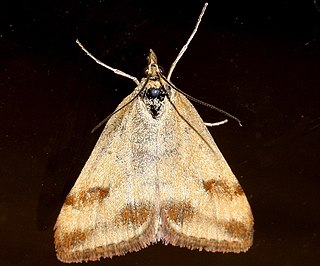Related Research Articles
Cryptobotys is a monotypic moth genus of the family Crambidae described by Eugene G. Munroe in 1956. Its only species, Cryptobotys zoilusalis, was described by Francis Walker in 1859. It is found in Cuba, Jamaica, Puerto Rico, Central America and the southern United States, where it has been recorded from Florida.
Paracorsia is a monotypic moth genus of the family Crambidae described by H. Marion in 1959. It contains only one species, Paracorsia repandalis, described by Michael Denis and Ignaz Schiffermüller in 1775. It is found in most of Europe, except Ireland, Fennoscandia and the Baltic region. It has also been recorded from central Asia, including Iran and Kyrgyzstan and North America where it has been recorded in southern Ontario and northern Indiana.
Raphiptera is a genus of moths of the family Crambidae. It contains only one species, Raphiptera argillaceellus, the diminutive grass-veneer, which is found in eastern North America, where it has been recorded from Labrador, Ontario, Wisconsin, Connecticut, New York, Quebec, Alberta and Michigan. The range extends to Florida and Texas in the south-east and Costa Rica in Central America. The habitat consists of bogs.
Thaumatopsis magnificus is a moth in the family Crambidae. It was described by Charles H. Fernald in 1891. It is found in North America, where it has been recorded from New Mexico, Arizona and Colorado.
Neoeromene parvalis is a moth in the family Crambidae. It was described by Francis Walker in 1866. It is found in the upper Amazon region, where it has been recorded from Brazil and Peru.
Evergestis triangulalis is a moth in the family Crambidae. It was described by William Barnes and James Halliday McDunnough in 1914. It is found in North America, where it has been recorded from Arizona, Nevada and New Mexico.
Dicymolomia opuntialis is a moth in the family Crambidae. It is found in North America, where it has been recorded from California.

Crocidophora serratissimalis, the angelic crocidophora moth or sawtoothed crocidophora, is a moth in the family Crambidae. It was described by Zeller in 1872. It is found in North America, where it has been recorded from Quebec and New England to South Carolina, west to Manitoba and possibly Texas.
Pyrausta coccinea is a moth in the family Crambidae. It was described by William Warren in 1892. It is found in North America, where it has been recorded from California.

Pyrausta semirubralis is a moth in the family Crambidae. It was described by Alpheus Spring Packard in 1873. It is found in North America, where it has been recorded from southern British Columbia to California, Nevada, Colorado and Arizona. The habitat consists of coastal areas, reaching inland up to altitudes of about 9000 ft.
Pyrausta subsequalis is a moth in the family Crambidae. It was described by Achille Guenée in 1854. It is found in North America, where it has been recorded from southern Alberta and southern British Columbia south to Arizona and New Mexico. The habitat consists of dry prairie areas.
Pyrausta zonalis is a moth in the family Crambidae. It was described by William Barnes and James Halliday McDunnough in 1918. It is found in North America, where it has been recorded from Texas, Arizona and California.
Pyrausta borealis, the northern pyrausta moth, is a moth in the family Crambidae. It was described by Alpheus Spring Packard in 1867. It is found in North America, where it has been recorded from Newfoundland and Labrador west to British Columbia, north to Alaska and the Yukon. The habitat consists of boreal forests.
Cosipara tricoloralis, the tricolored cosipara moth, is a moth in the family Crambidae. It was described by Harrison Gray Dyar Jr. in 1904. It is found in North America, where it has been recorded from British Columbia, California, Colorado, Montana, Oregon and Washington.
Canuza acmias is a moth in the family Crambidae. It was described by Edward Meyrick in 1897. It is found in Australia, where it has been recorded from New South Wales.
Gyros muirii is a moth in the family Crambidae. It was described by Henry Edwards in 1881. It is found in North America, where it has been recorded from California, Oregon and Washington.

Elaphria chalcedonia, the chalcedony midget moth, is a moth of the family Noctuidae. It is found in North America, where it has been recorded from the eastern United States, from Maine to Florida, west to Texas and north to Wisconsin. It is also found in Jamaica, Guadeloupe, Saint Martin, Puerto Rico and Central America. It was described by Jacob Hübner in 1808.

Sciota uvinella, the sweetgum leafroller moth, is a species of snout moth in the genus Sciota. It was described by Ragonot in 1887. It is found in North America, where it has been recorded from New Jersey to Florida, west to Texas and Kentucky.
Conchylodes octonalis, the eight-barred lygropia moth, is a snout moth in the family Crambidae. It was described by Zeller in 1873. It is found in North America, where it has been recorded from central and southern California to Texas and from Iowa, Mississippi, Nevada, New Mexico, Oklahoma and Tennessee. The habitat consists of low-elevation arid areas.
Phostria tedea is a moth in the family Crambidae. It was described by Stoll in 1780. It is found in the southern United States, where it has been recorded from Arizona, to Central America, including Mexico, Costa Rica and Belize.
References
- ↑ "global Pyraloidea database". Globiz.pyraloidea.org. Retrieved 2014-07-15.
- ↑ mothphotographersgroup
- ↑ BOLD Systems
- ↑ Bug Guide
- ↑ Hulst, J.D., 1886. The Canadian Entomologist 24: 63
| This Nomophilini-related article is a stub. You can help Wikipedia by expanding it. |